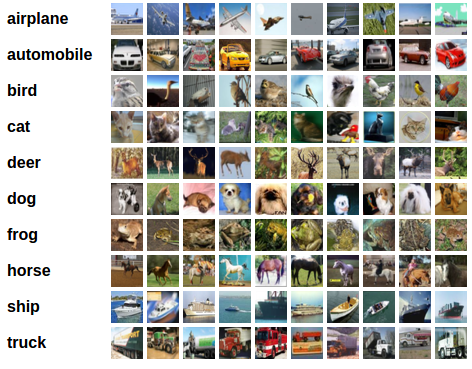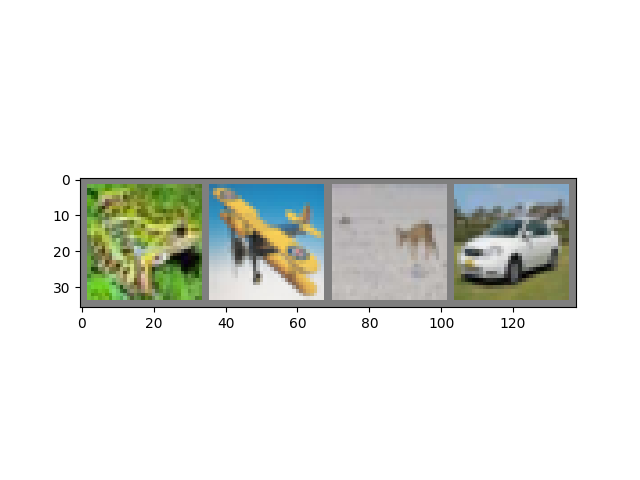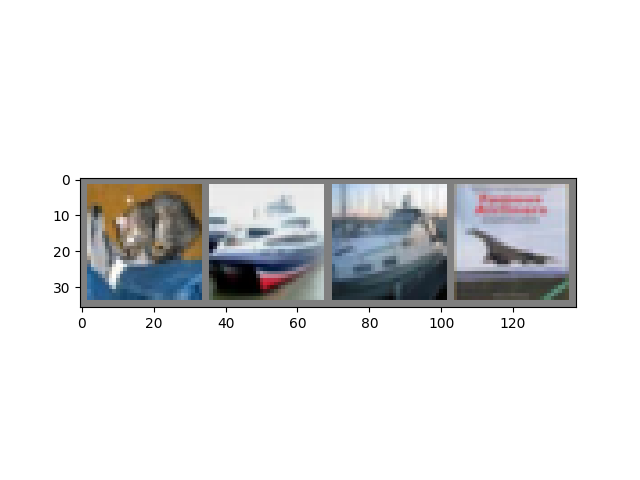注意
点击此处下载完整的示例代码
训练分类器¶
创建于: 2017 年 3 月 24 日 | 最后更新于: 2024 年 12 月 20 日 | 最后验证于: 未验证
就是这样。您已经了解了如何定义神经网络、计算损失以及更新网络权重。
现在您可能会想,
数据怎么办?¶
通常,当您需要处理图像、文本、音频或视频数据时,可以使用标准的 Python 包将数据加载到 numpy 数组中。然后,您可以将此数组转换为 torch.*Tensor。
对于图像,Pillow、OpenCV 等包很有用
对于音频,scipy 和 librosa 等包很有用
对于文本,可以使用原生 Python 或基于 Cython 的加载方式,或者使用 NLTK 和 SpaCy 等包
特别是在视觉领域,我们创建了一个名为 torchvision 的包,它包含了 ImageNet、CIFAR10、MNIST 等常见数据集的数据加载器,以及图像数据转换器,即 torchvision.datasets 和 torch.utils.data.DataLoader。
这提供了极大的便利,避免编写样板代码。
在本教程中,我们将使用 CIFAR10 数据集。它包含以下类别:‘airplane’(飞机)、‘automobile’(汽车)、‘bird’(鸟)、‘cat’(猫)、‘deer’(鹿)、‘dog’(狗)、‘frog’(青蛙)、‘horse’(马)、‘ship’(船)、‘truck’(卡车)。CIFAR-10 中的图像大小为 3x32x32,即大小为 32x32 像素的 3 通道彩色图像。

cifar10¶
训练图像分类器¶
我们将按以下步骤进行
使用
torchvision加载并归一化 CIFAR10 训练集和测试集定义一个卷积神经网络
定义一个损失函数
在训练数据上训练网络
在测试数据上测试网络
1. 加载并归一化 CIFAR10¶
使用 torchvision 加载 CIFAR10 非常容易。
import torch
import torchvision
import torchvision.transforms as transforms
torchvision 数据集的输出是范围在 [0, 1] 的 PILImage 图像。我们将它们转换为范围在 [-1, 1] 的归一化张量。
注意
如果在 Windows 上运行并出现 BrokenPipeError,请尝试将 torch.utils.data.DataLoader() 的 num_worker 设置为 0。
transform = transforms.Compose(
[transforms.ToTensor(),
transforms.Normalize((0.5, 0.5, 0.5), (0.5, 0.5, 0.5))])
batch_size = 4
trainset = torchvision.datasets.CIFAR10(root='./data', train=True,
download=True, transform=transform)
trainloader = torch.utils.data.DataLoader(trainset, batch_size=batch_size,
shuffle=True, num_workers=2)
testset = torchvision.datasets.CIFAR10(root='./data', train=False,
download=True, transform=transform)
testloader = torch.utils.data.DataLoader(testset, batch_size=batch_size,
shuffle=False, num_workers=2)
classes = ('plane', 'car', 'bird', 'cat',
'deer', 'dog', 'frog', 'horse', 'ship', 'truck')
0%| | 0.00/170M [00:00<?, ?B/s]
0%| | 459k/170M [00:00<00:37, 4.58MB/s]
4%|4 | 7.63M/170M [00:00<00:03, 44.1MB/s]
11%|# | 18.3M/170M [00:00<00:02, 72.2MB/s]
17%|#6 | 28.5M/170M [00:00<00:01, 83.9MB/s]
23%|##2 | 39.2M/170M [00:00<00:01, 92.1MB/s]
29%|##9 | 49.7M/170M [00:00<00:01, 96.5MB/s]
36%|###5 | 60.6M/170M [00:00<00:01, 101MB/s]
42%|####1 | 70.8M/170M [00:00<00:00, 101MB/s]
48%|####7 | 81.4M/170M [00:00<00:00, 103MB/s]
54%|#####3 | 91.8M/170M [00:01<00:00, 103MB/s]
60%|###### | 103M/170M [00:01<00:00, 104MB/s]
67%|######6 | 114M/170M [00:01<00:00, 106MB/s]
73%|#######2 | 124M/170M [00:01<00:00, 106MB/s]
79%|#######9 | 135M/170M [00:01<00:00, 107MB/s]
86%|########5 | 146M/170M [00:01<00:00, 105MB/s]
92%|#########1| 157M/170M [00:01<00:00, 105MB/s]
98%|#########8| 167M/170M [00:01<00:00, 104MB/s]
100%|##########| 170M/170M [00:01<00:00, 97.7MB/s]
让我们展示一些训练图像,以供参考。
import matplotlib.pyplot as plt
import numpy as np
# functions to show an image
def imshow(img):
img = img / 2 + 0.5 # unnormalize
npimg = img.numpy()
plt.imshow(np.transpose(npimg, (1, 2, 0)))
plt.show()
# get some random training images
dataiter = iter(trainloader)
images, labels = next(dataiter)
# show images
imshow(torchvision.utils.make_grid(images))
# print labels
print(' '.join(f'{classes[labels[j]]:5s}' for j in range(batch_size)))

frog plane deer car
2. 定义一个卷积神经网络¶
复制前面“神经网络”部分中的神经网络,并修改它以接收 3 通道图像(而不是之前定义的 1 通道图像)。
import torch.nn as nn
import torch.nn.functional as F
class Net(nn.Module):
def __init__(self):
super().__init__()
self.conv1 = nn.Conv2d(3, 6, 5)
self.pool = nn.MaxPool2d(2, 2)
self.conv2 = nn.Conv2d(6, 16, 5)
self.fc1 = nn.Linear(16 * 5 * 5, 120)
self.fc2 = nn.Linear(120, 84)
self.fc3 = nn.Linear(84, 10)
def forward(self, x):
x = self.pool(F.relu(self.conv1(x)))
x = self.pool(F.relu(self.conv2(x)))
x = torch.flatten(x, 1) # flatten all dimensions except batch
x = F.relu(self.fc1(x))
x = F.relu(self.fc2(x))
x = self.fc3(x)
return x
net = Net()
3. 定义损失函数和优化器¶
让我们使用分类交叉熵损失和带动量的 SGD。
import torch.optim as optim
criterion = nn.CrossEntropyLoss()
optimizer = optim.SGD(net.parameters(), lr=0.001, momentum=0.9)
4. 训练网络¶
这时候事情开始变得有趣了。我们只需遍历数据迭代器,将输入馈送到网络并进行优化。
for epoch in range(2): # loop over the dataset multiple times
running_loss = 0.0
for i, data in enumerate(trainloader, 0):
# get the inputs; data is a list of [inputs, labels]
inputs, labels = data
# zero the parameter gradients
optimizer.zero_grad()
# forward + backward + optimize
outputs = net(inputs)
loss = criterion(outputs, labels)
loss.backward()
optimizer.step()
# print statistics
running_loss += loss.item()
if i % 2000 == 1999: # print every 2000 mini-batches
print(f'[{epoch + 1}, {i + 1:5d}] loss: {running_loss / 2000:.3f}')
running_loss = 0.0
print('Finished Training')
[1, 2000] loss: 2.143
[1, 4000] loss: 1.833
[1, 6000] loss: 1.674
[1, 8000] loss: 1.574
[1, 10000] loss: 1.524
[1, 12000] loss: 1.445
[2, 2000] loss: 1.405
[2, 4000] loss: 1.363
[2, 6000] loss: 1.339
[2, 8000] loss: 1.342
[2, 10000] loss: 1.311
[2, 12000] loss: 1.274
Finished Training
让我们快速保存训练好的模型
PATH = './cifar_net.pth'
torch.save(net.state_dict(), PATH)
有关保存 PyTorch 模型的更多详细信息,请参阅此处。
5. 在测试数据上测试网络¶
我们已经对训练数据集进行了 2 次完整的训练。但我们需要检查网络是否学到了任何东西。
我们将通过预测神经网络输出的类别标签,并与真实标签进行对比来检查。如果预测正确,我们将样本添加到正确预测列表中。
好的,第一步。让我们显示测试集中的一张图像以熟悉情况。
dataiter = iter(testloader)
images, labels = next(dataiter)
# print images
imshow(torchvision.utils.make_grid(images))
print('GroundTruth: ', ' '.join(f'{classes[labels[j]]:5s}' for j in range(4)))

GroundTruth: cat ship ship plane
接下来,让我们重新加载我们保存的模型(注意:此处并非必须保存和重新加载模型,我们只是为了说明如何操作)。
net = Net()
net.load_state_dict(torch.load(PATH, weights_only=True))
<All keys matched successfully>
好的,现在让我们看看神经网络认为上面的这些示例是什么
输出是 10 个类别的“能量”。某个类别的能量越高,网络越认为图像属于该类别。因此,让我们获取能量最高的索引
Predicted: frog ship ship plane
结果看起来相当不错。
让我们看看网络在整个数据集上的表现。
correct = 0
total = 0
# since we're not training, we don't need to calculate the gradients for our outputs
with torch.no_grad():
for data in testloader:
images, labels = data
# calculate outputs by running images through the network
outputs = net(images)
# the class with the highest energy is what we choose as prediction
_, predicted = torch.max(outputs, 1)
total += labels.size(0)
correct += (predicted == labels).sum().item()
print(f'Accuracy of the network on the 10000 test images: {100 * correct // total} %')
Accuracy of the network on the 10000 test images: 55 %
这看起来比随机猜测(10 个类别中随机选择一个,准确率为 10%)好得多。看来网络学到了一些东西。
嗯,哪些类别的表现很好,哪些类别的表现不好呢?
# prepare to count predictions for each class
correct_pred = {classname: 0 for classname in classes}
total_pred = {classname: 0 for classname in classes}
# again no gradients needed
with torch.no_grad():
for data in testloader:
images, labels = data
outputs = net(images)
_, predictions = torch.max(outputs, 1)
# collect the correct predictions for each class
for label, prediction in zip(labels, predictions):
if label == prediction:
correct_pred[classes[label]] += 1
total_pred[classes[label]] += 1
# print accuracy for each class
for classname, correct_count in correct_pred.items():
accuracy = 100 * float(correct_count) / total_pred[classname]
print(f'Accuracy for class: {classname:5s} is {accuracy:.1f} %')
Accuracy for class: plane is 43.5 %
Accuracy for class: car is 67.2 %
Accuracy for class: bird is 44.7 %
Accuracy for class: cat is 29.5 %
Accuracy for class: deer is 48.9 %
Accuracy for class: dog is 47.0 %
Accuracy for class: frog is 60.5 %
Accuracy for class: horse is 70.9 %
Accuracy for class: ship is 79.8 %
Accuracy for class: truck is 65.4 %
好的,接下来该怎么办?
我们如何在 GPU 上运行这些神经网络?
在 GPU 上训练¶
就像将张量转移到 GPU 上一样,您也需要将神经网络转移到 GPU 上。
如果我们有 CUDA 可用,让我们首先将设备定义为第一个可见的 cuda 设备
device = torch.device('cuda:0' if torch.cuda.is_available() else 'cpu')
# Assuming that we are on a CUDA machine, this should print a CUDA device:
print(device)
cuda:0
本节的其余部分假设 device 是一个 CUDA 设备。
然后这些方法将递归地遍历所有模块,并将它们的参数和缓冲区转换为 CUDA 张量
net.to(device)
记住,您还需要在每一步将输入和目标发送到 GPU
为什么我没有注意到与 CPU 相比有巨大的加速?因为您的网络很小。
练习:尝试增加网络的宽度(第一个 nn.Conv2d 的参数 2 和第二个 nn.Conv2d 的参数 1 – 它们需要是相同的数字),看看能获得什么样的加速。
目标达成:
高度理解 PyTorch 的张量库和神经网络。
训练一个小型神经网络对图像进行分类



